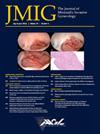整合靛氰绿 (ICG) 优化良性妇科手术
IF 3.5
2区 医学
Q1 OBSTETRICS & GYNECOLOGY
引用次数: 0
摘要
研究目的 展示手术教程,突出说明吲哚菁绿(ICG)在复杂妇科手术中的应用。设计 一段视频,说明 ICG 在各种手术环境中的应用。患者或参与者接受机器人辅助腹腔镜手术治疗深部子宫内膜异位症、保留神经的子宫切除术和保留子宫的子宫腺肌症手术的患者。干预措施静脉注射ICG(IV ICG)与传统白光一起使用,可提高浅表子宫内膜异位症的检测能力,并在吻合术前后评估肠道血管化情况。此外,静脉注射 ICG 还有助于在深部子宫内膜异位症手术中识别胃下神经、血管和输尿管。稀释的腔内 ICG 是另一种有益的方式,可在膀胱镜检查时直接注入输尿管以识别输尿管,在子宫腔内注射以检测破口,并优化子宫腺肌症切除术。腔内 ICG 还可以注入膀胱或直肠,从而对膀胱和肠道子宫内膜异位症进行精确的粘膜保留切除术。它可被视为进一步提高患者安全、降低发病率和改善手术效果的潜在候选方法。本文章由计算机程序翻译,如有差异,请以英文原文为准。
The Integration of Indocyanine Green (ICG) to Optimize Benign Gynecological Surgery
Study Objective
To demonstrate a surgical tutorial that highlights the integration of Indocyanine Green (ICG) in complex gynecological surgeries.
Design
A video footage illustrating the use of ICG in various surgical settings.
Setting
An endometriosis and adenomyosis referral center.
Patients or Participants
Patients undergoing robotic-assisted laparoscopic surgery for deep endometriosis, nerve-sparing hysterectomies, and uterus-sparing adenomyosis surgeries.
Interventions
Intravenous ICG (IV ICG) is used alongside conventional white light to enhance the detection of superficial endometriosis and assess bowel vascularization before and after anastomosis. Additionally, IV ICG aids in identifying hypogastric nerves, vessels, and ureters during deep endometriosis surgeries. Diluted intraluminal ICG is another beneficial modality that can be injected directly into the ureters during cystoscopy to identify the ureters, administered in the uterine cavity to detect breaches, and optimize adenomyosis excision. Intraluminal ICG can also be injected into the bladder or rectum, allowing for precise mucosal-sparing shaving excision of bladder and bowel endometriosis.
Measurements and Main Results
N/A.
Conclusion
ICG has various applications in benign gynecological surgery, guiding intraoperative decision-making. It could be considered a potential candidate to further enhance patient safety, decrease morbidity, and improve surgical outcomes.
求助全文
通过发布文献求助,成功后即可免费获取论文全文。
去求助
来源期刊
CiteScore
5.00
自引率
7.30%
发文量
272
审稿时长
37 days
期刊介绍:
The Journal of Minimally Invasive Gynecology, formerly titled The Journal of the American Association of Gynecologic Laparoscopists, is an international clinical forum for the exchange and dissemination of ideas, findings and techniques relevant to gynecologic endoscopy and other minimally invasive procedures. The Journal, which presents research, clinical opinions and case reports from the brightest minds in gynecologic surgery, is an authoritative source informing practicing physicians of the latest, cutting-edge developments occurring in this emerging field.

 求助内容:
求助内容: 应助结果提醒方式:
应助结果提醒方式:


